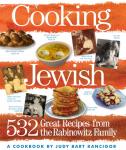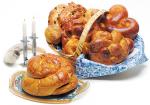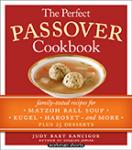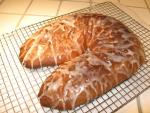
BUY COOKING JEWISH by clicking here now.
What is Cooking Jewish?
Contact Judy at judy@cookingjewish.com
 Cooking Jewish is tradition—heirloom recipes passed down through the generations. Cooking Jewish is devising modern spins on old classics. Cooking Jewish is preserving memories as we create new ones. Cooking Jewish is cooking from the heart, a memory in every bite.
Cooking Jewish is tradition—heirloom recipes passed down through the generations. Cooking Jewish is devising modern spins on old classics. Cooking Jewish is preserving memories as we create new ones. Cooking Jewish is cooking from the heart, a memory in every bite.
And you don't have to be Jewish to cook Jewish!
There are very few dishes that can be exclusively called Jewish. Wherever Jews have wandered, they have incorporated the cuisine of their neighbors into that serendipitous amalgamation we think of as "Jewish food."
We are the ancestors of the coming generations and the keepers of memories for our children. We treasure our heritage as we create new traditions.
Food and family, family and food....I can't think of one without the other. Let's eat together, celebrate together, and enjoy!
New Passover e-book from Cooking Jewish!

Tradition! Tradition! Got kugel? Got Kugel with farfel? Now you do!
My favorite Passover recipes from Cooking Jewish are now available in a short, handy, digestible e-book: The Perfect Passover Cookbook (Workman Publishing), for your e-reader, available on amazon, barnes and noble or wherever e-books are sold.
These 54 recipes are gathered from five generations of my food-obsessed family into a celebratory saga of Passover feasts.
You'll just go mashuga for:
Gnocchi for Passover!
The
Orange County Register/Fullerton News Tribune
April 3, 2014
Kosher gnocchi means you don't have to pass on
kitchen delights during Passover
Seating ancient and new at the same table
My column on OU's website, Shabbat Shalom includes recipes for My Chicken Marbella from "Cooking Jewish," Orange Beets with Almonds from "The Healthy Jewish Cookbook by Michael van Straten and Apricot Jelly Roll from Joan Kekst's "Passover Cookery"
Passover is the most observed Jewish holiday of the year. Even those who never step inside a synagogue pull out all the stops for this one. With our celebratory meal, the Seder, we retell the 3500-year-old story of our ancestors' flight to freedom from the land of Egypt. And everything on the table is laden with meaning.
The centerpiece is the Seder plate, holding the traditional symbols. On every Seder plate sits karpas (a green vegetable), the symbol of spring, which we dip into salt water as we remember the tears shed by our ancestors. Actually for Jews in the shtetls (little villages) in Eastern Europe, spring arrived late, and greens were rare at Passover time. "My father's family always used potato," suggested my friend Yiddish songstress Lori Cahan-Simon, "but added parsley as karpas in the new country, so we have, in effect, parsley potatoes!" Read the whole story.
Vibrant foods flavor the Passover feast
The Orange County Register, April 17, 2008
Two new cookbooks offer traditional and fresh looks at the holiday menu.
by JUDY BART KANCIGOR
When Sarine and Murad Kattan left Aleppo, Syria, in 1947 for their honeymoon in Italy, their thoughts were of love and their future in their beloved homeland, where their family and the larger Jewish community had lived and flourished for centuries.
Back in Aleppo, the announcement of the United Nations partition of Palestine fueled the already smoldering atmosphere of anti-Semitism, setting off pogroms (organized massacres) that virtually extinguished all Jewish life, erasing centuries of this rich, thriving culture.
Find recipes for Chicken Soup With Asparagus and Shiitakes, Served With Roasted Fennel Matzo Balls and Braised Brisket With Thirty-Six Cloves of Garlic from Jewish Holiday Cooking when you read the whole story. For Stuffed Eggplant with Quince recipe from Aromas of Aleppo click here and for Candied Coconut with Pistachios click here.
Making holiday memories
Canadian Jewish News April 2008
by Judy Bart Kancigor
Happy New Year! No, I haven't forgotten how to read a calendar (and can still find my way home and hardly ever drool on my sweater.) For Jews preparing for Passover (beginning Saturday evening, April 19) the spring holiday is another way to mark the beginning of the Jewish year.
While Rosh Hashanah, literally translated “head of the year,” is the spiritual new year, Nissan, the month of Passover, is sometimes considered the first month, because it denotes the beginning of our liberation from slavery and the exodus of our ancestors from Egypt.
And just in time for Passover, the culinary crescendo of the year for Jewish cooks, comes the long-awaited “Passover by Design” (Artscroll) from Susie Fishbein, with over 130 Passover-adjusted recipes, plus 30 brand-new ones, and the leap-off-the-page, glorious photos and clever décor ideas we have come to expect from this wildly popular author of the Kosher by Design series.
“Passover by Design” contains many of the recipes we love in Fishbein’s previous books, conveniently reformulated for the holiday, plus some enticing additions, including Teriyaki Chicken Satés, Beef Roulade on Creamy Parsnips, Sliced Beef with Shiitakes and Cherry Brandy Sauce, Steamed Sea Bass in Savoy Cabbage, Cranberry Chicken, Quinoa Timbales with Grapefruit Vinaigrette and Chocolate Chip Cheesecake.
Celebrating Passover with her large, lively family brings back vivid memories, said Fishbein by phone from her home in New Jersey. “It was just a frenzy, people of all ages celebrating together. The women tended to live into their nineties. That was always so beautiful, so many generations sitting at the table. There were so many people, so much to do. It was just a really happy, busy time.”
Got matzoh?
The festival of Passover, which begins this year at sundown on Wednesday, commemorates the exodus of the Hebrew slaves from Egypt. Because in their haste to depart they could not wait for their bread to rise, the dough was baked in flat cakes. To commemorate our passage to freedom, Jews throughout the world eat matzo for the eight-day holiday (seven in Israel). Strict rabbinical rules govern every aspect of its production.
“Our process with our Passover matzoh,” explained David Rossi, vice-president of marketing for RAB Food Group, owners of the Manischewitz brand, “from the time water touches the flour and gets mixed, then sheeted, made thinner and thinner, to the end of baking in the oven – can be no longer than 18 minutes. If there is a mechanical failure or some issue or error where the matzoh did not get through that run in 18 minutes, then the whole run must be thrown away.”
Before the company can begin production for Passover, the entire facility must be thoroughly cleaned and inspected – a procedure that makes Mama Hinda’s routine seem like a light dusting.
“The process takes four to seven weeks,” Rossi noted. “All the belts, all the lines, all the motors, all the ovens are cleaned and kashered (made kosher) to meet strict rabbinical standards for Passover.”
Turning out hundreds of Passover items, in addition to 10 varieties of matzo – spelt is Manischewitz’s new flavor this year – is no overnighter. “We begin making Passover products in September until early March for the following year,” Rossi noted. “Because the plant is kashered at tremendous expense, we produce Passover products until we’ve run all the requirements for the year. Then in March we start making non-Passover products.”
Passover - spring cleaning on steroids!
My grandmother, Mama Hinda, was a burier. No, not an undertaker. Okay, spell it berye. Yiddish for major-domo cleaner extraordinaire. As in white glove test above the door frame. As in you could eat off the floor. As in using the basement oven to keep the upstairs kitchen clean.
And if Mama was thorough during the year, before Passover she was fanatic, whipped to a joyous frenzy to ready the house for the holiday and remove all chometz (bread or any food containing leaven)…every last crumb.
Weeks before she would scrub, scour, scald, polish and shine. As the holiday approached, her Passover dishes – one set for milchig (dairy) and one set for fleishig (meat) – would be brought from the basement and washed. My Aunt Sally remembered, when she was a child in the 1920’s, Mama soaking glasses for three days and burying silverware outside with hot coals for use during the holiday. No closet, no shelf, no corner evaded her purification ritual.
On the night before Passover, Papa Harry and the children would search the already scoured home for any remaining crumbs of chometz, which would be swept up with a feather and burned. (So stringent is the prohibition that Jews are forbidden not only to consume, but even to possess such things as bread, noodles, yeast and other leavening agents, or anything made with flour during the holiday.)
Downstairs in the cold cellar, the earthen crock of rossl (fermented beets) Mama had started weeks before stood ready to infuse her borscht (beet soup), and eggs by the crate awaited her practiced hand to whisk them into ethereal citrus sponge cakes and irresistible chocolate nut tortes.
Rising to the occasion
In a jam? Try this recipe for Hanukkah doughnuts.
The Orange County Register/Fullerton News Tribune
November 29, 2007
by Judy Bart Kancigor
An old joke goes like this: The Jewish holidays are always either early or late. They’re never on time!
Hanukkah sneaks up on us early this year. We’ll begin lighting candles at sundown on December 4, so prepare for an oil crisis, and I’m not referring to the price of gas. Who knew when Judah Maccabee's tiny flask of oil miraculously burned for eight days that for thousands of years Jewish families would celebrate by frying!
While Jews of Eastern Europe descent eat mountains of latkes (potato pancakes), the Hanukkah treat in Israel is sufganiyot (jelly doughnuts).
Fullerton's Pnina Shichor, a former teacher and proprietor of Bound to Travel on Euclid, has been making them for years.
"When my children were young," she recalled, "my cousin, Esther Schechter, and I would do Hanukkah at Rolling Hills Elementary School. We'd tell the story, sing songs, and teach the children to make sufganiyot."
When the Shichors were considering transferring daughter Nomi to Jewish day school, Nomi said, "But, Mom, if I go there, who will do Hanukkah for our class?"
Pnina's mother-in-law, Malka Suranyi, brought the recipe from Budapest where the family survived under Nazi rule. Luckily an uncle owned an exclusive men's clothing store, which the Nazis wanted, so they kept the workers alive. After the war the Communists took over, and Pnina's husband, David, professor of criminal justice at Cal State San Bernardino, was barely 16 when the Jewish Agency smuggled him and other children out of Hungary.
Chocolate for Hanukkah - why not?
While Jews of Eastern European descent celebrate Hanukkah with mountains of latkes, Sephardic Jews fry sufganiyot. But for everyone – and every holiday – there’s always…chocolate?
Yes, just about everyone’s favorite ingredient never goes out of season, claims award-winning author Alice Medrich, whose book “Chocolate Holidays: Unforgettable Desserts for Every Season” (Artisan) offers 50 luscious, decadent recipes to crown every holiday and celebration.
“I wanted to do a season-to-season book,” said Medrich by phone from her Berkley, California, home. “Other ingredients we like to cook with change with the seasons. The constant is chocolate.”
Jewish cooks know that Hanukkah is all about the oil. The symbolism goes back to ancient times, when Judah Maccabee and his tiny army defeated the Syrian-Greeks and recaptured Jerusalem. In attempting to rededicate the Temple, they found only enough oil to burn for one day. Miraculously it lasted eight days, and we've been celebrating with a frying frenzy ever since! But who says traditional potato latkes are the only fritter fit to fry?
“Chocolate Banana Blintzes are fried, and Hanukkah is a great excuse to serve them,” noted Medrich. “They are just so delicious, a fancy party dessert that’s easy to do.” Restraint, she said, is sometimes the secret ingredient. “A little burst of chocolate sauce in a hot crepe with bananas is more seductive than a chocolate blintz with chocolate filling,” she writes.
Another lesser-known Hanukkah tradition involves the story of Judith, a beautiful Jewish widow, who dined with the enemy general Holofernes. She plied him with cheese to make him thirsty for wine, and when he fell into a drunken stupor, she beheaded him with his own sword. Because her bravery is said to have inspired the Maccabees, some communities remember Judith by eating cheese during this holiday.


